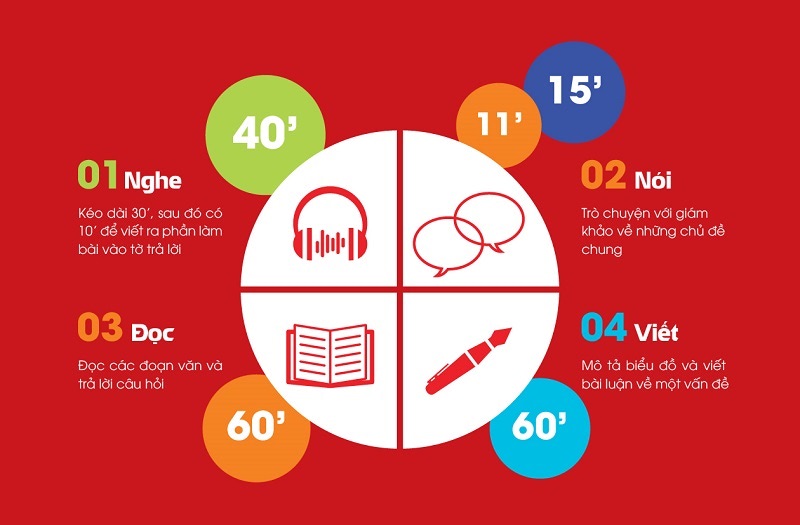Nowadays, IELTS is becoming more and more popular. This is a ticket to help you enter quality schools as well as a ticket for you to have a good career.
There are 2 types of IELTS exam: IELTS Academic (for those who want to pursue an academic path) and IELTS General Training (for those who want to work in English-speaking countries). Basically, an IELTS test will include 4 skills: Listening, Speaking, Reading, Writing. Let’s find out carefully with Hung Nguyen Education what the IELTS test sections include.
1. Listening
The IELTS listening test is designed to test the ability to grasp key information in the listening passage, and monitor how the speaker develops arguments and opinions.
| Exam structure | Candidates will listen to 4 different conversations/speeches spoken by native speakers. – Part 1 – A conversation between two people about social topics in daily life – Part 2 – One person talks about a social topic – Part 3 – A group of people discuss a topic in a school setting – Part 4 – One person presents a scientific topic |
| Time | Paper-based exam format: The test will last about 30 minutes and 10 minutes to write the answer sheetComputer format: The test will last about 30 minutes and there is no time to transfer answers |
| Question number | 40 sentences |
| Question type | There are many types of questions in the listening section as follows:
|
| Score | Each correct answer will be given 1 point, the total score will then be converted on a 9-point scale |
| Note | IELTS Academic and IELTS General will take the same Listening test |
2. Reading
The purpose of the IELTS reading test is to test your ability to grasp the main idea of paragraphs and essays, understand the details in the article, grasp how the author develops and argues his or her point of view, and understand the point of view and purpose. purpose of the article.
2.1 Structure of the IELTS Academic reading test
| Exam structure | Candidates will read 3 passages and answer a series of questions in many different types of articles. Readings are often taken from books and scientific magazines with necessary life and science topics for those who want to pursue undergraduate and graduate programs. |
| Time | 60 minutes |
| Question number | 40 sentences |
| Question type | IELTS Reading test types
|
| Score | Each correct answer will be counted as 1 point. |
| Note | The secret to doing well in the IELTS Reading test is vocabulary. When reviewing, you need to build your vocabulary to be able to grasp the main idea of the article. |
2.2 Structure of the IELTS General Training reading test
| Exam structure | The reading will be divided into three parts Part 1 – readings of texts will have topics related to ‘social life’. These will be paragraphs that include announcements, advertisements, and schedules. Part 2 – Topics usually focus on ‘work environment’. The paragraphs will be from job descriptions, contracts, and employee training materials. Part 3 – concerns general information. This will include texts from magazines, newspapers and excerpts from books. |
| Time | 60 minutes |
| Question number | 40 sentences |
| Question type | Reading lesson types:
|
| Score | Each correct answer counts as 1 point, the total score will then be converted on a 9-point scale |
| Note | The secret to doing well in the IELTS Reading test is vocabulary. When reviewing, you need to build your vocabulary to be able to grasp the main idea of the article. |
3. Writing
The Writing test is designed to test the ability to present and argue personal opinions on a topic. Also, check the ability to describe the data.
3.1 Structure of the Writing test – IELTS Academic
| Exam structure | In the IELTS Academic Writing test, candidates will have to complete both writing parts. Task 1 – Describe visual information in visual formYou rely on charts, graphs, tables, process drawings and describe events and numbers in your own language. me. This is an academic paper of 150 words in length.Task 2 – Express your opinion about an argument or point of view The test will ask you to present your views and arguments on an academic topic. Opinions should be based on logical arguments and evidence. In both parts of the test, you should use grammar and academic vocabulary. |
| Time | 60 minutes |
| Score | The exam is evaluated by the examiner. Part 2’s score will be higher than part 1 |
| Note | When doing homework, you should allocate reasonable time for Task 1 and Task 2. |
3.2 Structure of Writing for IELTS General Training
| Exam structure | The written test consists of 2 parts Part 1 – Letter writingThe topic is a common situation in everyday life such as school or work. You will have to write a letter to convey and exchange information. The article must be at least 150 words long.Part 2 – Express your opinion on an argument or point of view You are required Candidates will be provided with information about a point of view, argument or issue. Then, write an essay to discuss the given topic in more depth (the topic can revolve around education, the environment, or various family issues). |
| Time | 60 minutes. |
| Score | The exam is evaluated by the examiner. Part 2’s score will be higher than part 1 |
| Note | A reasonable amount of time should be allocated for the two written sections |
4. Speaking test
Speaking test to test language reflexes. The examiner will ask you questions for you to answer. You need to show fluency and the ability to develop ideas when speaking.
| Exam structure | In IELTS Speaking, there will be 3 test parts as follows: Part 1 – Introduction and interview: The judge will introduce himself and confirm the contestant’s identity. You will then be asked short questions about familiar life topics. Part 2 – Expressing personal opinion:You are asked to present a discussion on a given topic. You will have 1 minute to prepare ideas based on the suggested questions, then there will be 1-2 minutes of uninterrupted presentation. After completing your presentation, the examiner may ask 1-2 questions related to your exam.Part 3 – Discussion: The examiner will ask in-depth questions about the topic in part 2. This part requires a higher level of logical reasoning and problem presentation ability than part 1. |
| Time | about 15 minutes |
| Score | IELTS examiners will evaluate candidates’ communication skills based on the ability to present problems fluently, the ability to flexibly use language, vocabulary and grammar, and pronunciation |
| Note | You should not try to complicate your answer. Most importantly, you are comfortable presenting your own language. |









